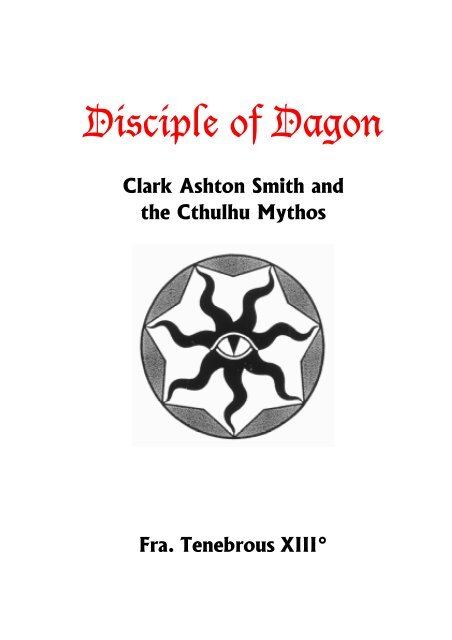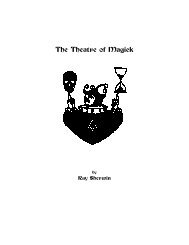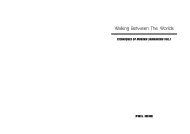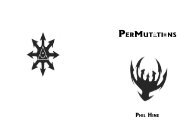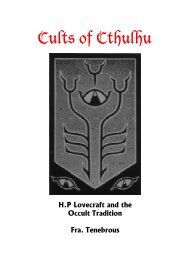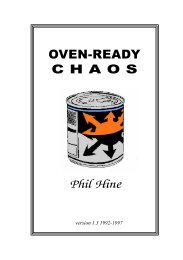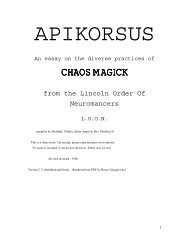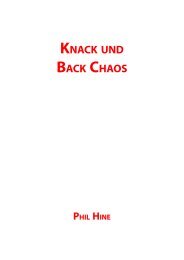Disciple of Dagon - Phil Hine
Disciple of Dagon - Phil Hine
Disciple of Dagon - Phil Hine
- No tags were found...
Create successful ePaper yourself
Turn your PDF publications into a flip-book with our unique Google optimized e-Paper software.
<strong>Disciple</strong> <strong>of</strong> <strong>Dagon</strong>Clark Ashton Smith andthe Cthulhu MythosFra. Tenebrous XIII°
DISCIPLE OF DAGONClark Ashton Smith and the Cthulhu Mythosby Fra. Tenebrous XIIIºFirst Published by Miskatonic University Press 1987 e.v.Limited edition <strong>of</strong> 123 copiesThis on-line edition November 1998 with kind permission <strong>of</strong>the author.Cover image: The Demon-Seal <strong>of</strong> Cthulhu by Fra. Tenebrous.
Clark Ashton Smith(1893-1968)
For here, apart, dwells one whose hands have wroughtStrange eidola that chill the world with fear;Whose graven runes in tomes <strong>of</strong> dread have taughtWhat things behind the star-gulfs lurk and leer.Dark Lord <strong>of</strong> Averoigne - whose windows stareOn pits <strong>of</strong> dream no other gaze could bear.H.P. Lovecraft, 1936During the 1930’s, three American writers <strong>of</strong> fantasy and horrorfiction contributed to an interlinked, correlative catalogue <strong>of</strong>work, consisting <strong>of</strong> short stories and novelettes, which laterbecame known as the Cthulhu Mythos. These stories concernthe return to Earth, after millenia <strong>of</strong> absence, <strong>of</strong> certain transdimensionalgods and entities, the Mythos taking its name fromthe central deity. The first, and most important <strong>of</strong> these writerswas Howard <strong>Phil</strong>ips Lovecraft, <strong>of</strong> Providence, Rhode Island.The second, more widely known for his tales <strong>of</strong> epic fantasyin exotic settings, was Robert Ervin Howard, <strong>of</strong> Cross Plains,Texas. The third, and equally fascinating writer, sculptor andpainter, was Clark Ashton Smith.Clark Ashton Smith was born on January 13, 1893, in LongValley, California. Like H.P Lovecraft, he could trace hisancestry back to New England and Europe - his mother’sfamily, the Gaylords, part <strong>of</strong> the Huguenot Gaillards, had fledto New England after the revocation <strong>of</strong> the Edict <strong>of</strong> Nantes.
Smith’s father, Timeus Smith, travelled extensively in earlylife, finally settling in the town <strong>of</strong> Auburn, California, wherehe was to remain until his death in December, 1937. And itwas here, on a 39 acre backwoods estate only six miles fromhis birthplace, that Clark Ashton Smith also lived and workedfor the greater part <strong>of</strong> his life, sharing a four-roomed woodencabin with his ageing parents.A highly sensitive child, Smith found school life unbearable 1 ,and after five years his parents took him out <strong>of</strong> grammar school.From this time on, Smith was wholly self-educated, gaining acomprehensive mastery <strong>of</strong> English usage, as well as enough<strong>of</strong> French and Spanish to compose verse in these languages.He began writing in earnest at the comparatively early age <strong>of</strong>eleven, and by 1910 he was selling his stories to such magazinesas The Black Cat and The Overland Monthly.However, it was for his poetry that he initially received publicattention and acclaim - his first collected volume, The StarTreader and other Poems appeared two years later. This volumewas greeted with front page reviews in the San Franciscanpress, who hailed Smith as “the Boy Genius <strong>of</strong> the Sierras”and “the Keats <strong>of</strong> the Pacific Coast”. In 1918, the prestigiousBook Club <strong>of</strong> California published a second collection - adeluxe edition <strong>of</strong> Odes and Sonnets, with an introduction bySmith’s close friend and mentor George Sterling. In these earlydays, Smith moved freely in the artistic and bohemian circles<strong>of</strong> San Francisco, which at this time included such literaryfigures as Jack London, Ambrose Bierce and DashiellHammett.By 1922, however, interest in Smith’s poetry was beginningto wane, and his next publication, Ebony and Crystal wasissued privately, financed by Smith himself. Lovecraftdescribed the long poem “The Hashish Eater”, contained in
this volume, as the “greatest imaginative orgy in Englishliterature.” Smith was greatly influenced by his favourites <strong>of</strong>this period - the works <strong>of</strong> Poe, William Beckford’s Vathek,and Sir Walter Scott’s tales <strong>of</strong> the Arabian Nights - which lefta permanent impression on his own elaborate and lyrical style.It is important to remember though, that it was Lovecraft, incorrespondence to Smith dating from August 1922, who firsturged him to begin experimenting with the newly-popularhorror fiction genre. (Lovecraft was later to send samples <strong>of</strong>Smith’s writing to Edwin Baird, editor <strong>of</strong> “Weird Tales”, andsuggest that he contact Smith with regard to publishing hisstories.)Over the next decade, Smith contributed to over fiftymagazines, including “The Yale Review”, “The LondonMercury”, “Asia”, “Wings”, and “The <strong>Phil</strong>ippine Magazine”.His translations from Baudelaire (another important influence)were included in an anthology <strong>of</strong> The Flowers <strong>of</strong> Evil publishedby the Limited Editions Club. But it was not until May 1930,with the publication in “Weird Tales” (an American pulpmagazine specialising in horror and supernatural fiction) <strong>of</strong> anarrative entitled paradoxically “The End <strong>of</strong> the Story”, thatSmith embarked upon what was to be a major contribution tothe literature <strong>of</strong> the fantastic. From that date until 1934, whenhe virtually stopped writing, he produced over 100 short stories,mostly for magazines such as “Weird Tales”, “Strange Tales”and “Wonder Stories”, and “Stirring Science Stories”. The best<strong>of</strong> these were anthologised as The Double Shadow and OtherFantasies (1933), Out <strong>of</strong> Space and Time (1942), Lost Worlds(1944), Genius Loci and other Tales (1948), and TheAbominations <strong>of</strong> Yondo (1960). He also started and abandoned,two novels.Fritz Leiber, another contributor to the Cthulhu Mythos, hascompared Smith’s stories to “Innsmouth Jewellery; like strange
ornaments, the metal elaborately inlaid and fired, studded withunknown semi-precious stones, from an unknown and timelessculture.” Certainly, one <strong>of</strong> the strongest characteristics <strong>of</strong>Smith’s prose is its sheer over-abundance <strong>of</strong> outré detail andoccurrence, almost a kind <strong>of</strong> descriptive excess. (This verbalextravagance is at its most extreme in his science-fiction andscience-fantasy pieces.) However, another aspect soon becomesapparent to the reader, the dry humour and irony whichunderlies many <strong>of</strong> his stories. To a degree, these qualities helpto <strong>of</strong>fset or counterbalance some <strong>of</strong> his more acute deviationsinto purple prose.The majority <strong>of</strong> Smith’s tales <strong>of</strong> cosmic horror take place inlocales far removed from the mundane world - in otherdimensions, on other worlds, in the distant past or far future.Certain groups <strong>of</strong> stories are linked by a common imaginarysetting - “Hyperborea”, the mythical northern continent,claimed by Madame Blavatsky to have been the earliestterrestrial civilisation; “Zothique”, a land at the very end <strong>of</strong>Earth’s life-span; or “Xiccarph”, a distant planet teeming withexotic flora and fauna. Another story-cycle is set in theimaginary medieval kingdom <strong>of</strong> Averoigne. His strongestnarratives, however, take place in Smith’s own neighbourhoods<strong>of</strong> San Francisco and Auburn. Against these commonplaceeveryday backgrounds, his trans-dimensional horrors seem allthe more effective.Though Clark Ashton Smith was undoubtedly influenced inhis poetry by the English Pre-Raphaelite and French Symbolistpoets, it was the work <strong>of</strong> the New England writer H.P. Lovecraftwhich was to prove the single most important influence on hisfantasy fiction. Of the contemporary writers who contributedto Lovecraft’s Cthulhu Mythos, Smith was the most prolific,encouraged by Lovecraft himself. Lovecraft welcomed theadditions to the cosmology <strong>of</strong> the Old Ones, and incorporated
them into his own works in progress. To the original pantheon<strong>of</strong> deities (Cthulhu, Yog-Sothoth, <strong>Dagon</strong>, Hastur, Nyarlathotepand Shub-Niggurath), Smith contributed such entities as “theblack and amorphous god Tsathoggua”; the spider-god “Atlach-Nacha”, and the primal deity, “Ubbo-Sathla”. To the Mythoslist <strong>of</strong> infamous and forbidden grimoires - the “Necronomicon”,“Unausrechlichen Kulten” and “Cultes des Goules”, he added“The Book <strong>of</strong> Eibon, a collection <strong>of</strong> dark and baleful myths,<strong>of</strong> liturgies and incantations both evil and esoteric.”Less superficially, Smith was able to imbue his mythos taleswith a sense <strong>of</strong> the vast epochs <strong>of</strong> time, the strange eons throughwhich the Old Ones have slumbered, awaiting the time whenthe stars are right, and they will again rule the earth. In “Ubbo-Sathla”, a modern day occultist discovers a magical crystalthrough which he regresses, via past incarnations and atavisticreversions, to the protoplasmic souce <strong>of</strong> all terrestrial life. In aquotation from the ‘Book <strong>of</strong> Eibon, Smith describes this entityin a phrase very reminiscent <strong>of</strong> Lovecraft’s ‘Old Ones -“...For Ubbo-Sathla is the source and the end. Before thecoming <strong>of</strong> Zhothaqquah or Yok-Zothoth or Kthulhut fromthe stars, Ubbo-Sathla dwelt in the steaming fens <strong>of</strong> thenew-made Earth.”In “The Return <strong>of</strong> the Sorcerer”, a young scholar is hired bya wealthy recluse living in Oakland, California, to translatepassages from the “Necronomicon” - Smith includes withinthe text <strong>of</strong> the story a passage from the most famous <strong>of</strong>Lovecraftian grimoires. His next piece in print, “The Tale <strong>of</strong>Satampra Zeiros” (published in the November 1931 issue <strong>of</strong>‘Weird Tales’), contains the first reference to the god“Tsathoqqua”. Lovecraft had incorporated this deity into his
own story, “The Whisperer in Darkness”, in the followingpassage;“Its from N’Kai that frightful Tsathoggua came - theamorphous toad-like god-creature mentioned in therPnakotic Manuscripts and the Necronomicon and theCommorian myth-cycle <strong>of</strong> Klarkash-Ton.”“Klarkash-Ton” is <strong>of</strong> course a reference to Smith himself -the “Commorion myth-cycle” refers to his series <strong>of</strong> stories setin Hyperborea. As “The Tale <strong>of</strong> Satampra Zeiros” waspublished two months after Lovecraft’s story, it would appearthat Smith had shown Lovecraft a copy <strong>of</strong> the manuscriptsometime before 1931.Another tale in the same sequence, “The Door to Saturn”,introduced the Hyperborean wizard, “Eibon”, as well aspresenting more information concerning Tsagthoggua, namingthe beings which spawned him, and the planet (Saturn) fromwhich he descended to the Earth. “The Nameless Offspring”,published only a few months later in Strange Tales, beginswith another long quotation from the “Necronomicon <strong>of</strong> AbdulAlhazred”;“Many and multiform are the dim horrors <strong>of</strong> the Earth,infesting her ways from the prime. They sleep beneath thesea and in subterranean places...”This piece clearly shows Smiths deepening interest andinvolvement with the basic themes <strong>of</strong> the Cthulhu Mythos.Though only eight <strong>of</strong> Smiths stories 2 can strictly be classed asbeloging to the Cthulhu Mythos, if the usual criteria <strong>of</strong> theinclusion <strong>of</strong> related god-names, locations and grimoires are
applied, others certainly share the atmosphere and structure <strong>of</strong>the typical mythos tales. Such stories include “Genius Loci”,“The Treader <strong>of</strong> the Dust”, “The Seed from the Sepulchre”,and “The Devotee <strong>of</strong> Evil” - there would seem to be a goodcase for their inclusion in the mythos on purely stylisticgrounds.Many <strong>of</strong> Smith’s plots also echo those found in Lovecraft’sfiction - for example, “The Hunters from Beyond”, which bearsa close resemblance to Lovecraft’s story, “Pickman’s Model”.In both, an artist’s representation <strong>of</strong> sub-human monsters arerevealed to be taken ‘from life. The theme <strong>of</strong> this story mayalso in a sense be symbolic., for Smith was himself a prolificvisual artist, producing a huge number <strong>of</strong> paintings, drawingsand sculptures, many <strong>of</strong> subjects which parallel his writtenwork. His colour paintings <strong>of</strong> bizarre vegetation and fungidepict landscapes from his imaginary worlds, Hyperborea andAtlantis. He also illustrated scenes from his own stories, andthose <strong>of</strong> Lovecraft, 3 executed in watercolor and crayons.Though these images are stylistically rather crude, they havean underlying primitive power, and have been favourablycompared to the paintings <strong>of</strong> the symbolist, Odilon Redon,particularly with regard to Redon’s later colour work. In hismemoir <strong>of</strong> Clark Ashton Smith, E. H<strong>of</strong>fman Price describeshis first viewing <strong>of</strong> Smith pictures:“Pencil - crayon - watercolour - many, pen drawn, withinks <strong>of</strong> diverse colours, these being done in laboriouslyminute detail. Some were two-dimensional equivalents <strong>of</strong>his sculptures. Other were ornate and highly stylizedrepresentations <strong>of</strong> plant life which appeared to be mergingwith the animal kingdom.”
Of greater interest perhaps are Smith’s miniature sculpturespieces, mostly small enough to be held in one hand. Amongstthese are subjects from the Mythos, as suggested by titles suchas ‘Cthulhu’, ‘<strong>Dagon</strong>’, ‘Tsathoggua’, ‘The Outsider, andHastur’; others are bizarre heads like those <strong>of</strong> Easter Island.These pieces, <strong>of</strong>ten carved from the rare and unusual stonesfound in the California foothills, evoke comparison with certainforms <strong>of</strong> pre-Columbian and Polynesian artefacts. Concerningthese sculptures (which Smith fired in his kitchen stove) Pricerecalls:“many were android: subhuman, quasi-human,superhuman -comfortably gross- acutely devilish - stupidlycomfortable -sinister - malicious - full figures - busts - mereheads...”Unlike Lovecraft, who was a conspicuously introverted andself-effacing individual, Smith also worked at a variety <strong>of</strong> nonliteraryoccupations - as a fruit-picker, lumberjack, digger <strong>of</strong>wells, gardener and hard-rock miner - and seems to haveenjoyed a robust, outdoor existence. These part-time jobs alsoallowed him to produce highly individual stories without theneed to consider their commercial potential, as he never hadto rely soely upon the revenue from his literary and artisticendeavours. Smith also had a liking for strong liquor - againin marked contrast to Lovecraft’s apparent abstinence.In the spring <strong>of</strong> 1934, for no apparent reason, Smith’s copiousoutput <strong>of</strong> stories came to an abrupt end. From this time untilhis death in 1961, he produced only a handful <strong>of</strong> tales, despitethe fact that he had become one <strong>of</strong> the most prolific and popular<strong>of</strong> the “Weird Tales” writers, and was at the height <strong>of</strong> hiscreative powers. It seems as if the informative current which
had found its outlet in Smith fantasy fiction had been cut <strong>of</strong>for withdrawn. This is all the more remarkable when consideredin parallel to Lovecraft’s career - he also stopped writing shortlyafter this time, and died within a year and a half <strong>of</strong> completinghis last story.In the same way as an Occult lodge may be established inorder to transmit a particular magical current over a particularperiod <strong>of</strong> time (perhaps determined by astrologicalconsiderations), it appears that the ‘Lovecraft Circle’ <strong>of</strong> writers 4provided, in the late Twenties and early Thirties, a focal pointor ‘receiver’ for the elements <strong>of</strong> the Mythos. The fact that thisprocess was largely a subconscious one, merely demonstratesthat is is when the imagination is operating most strongly, andhelping to block’ the rational, conscious mind, that thetransmissions <strong>of</strong> ‘magical’ knowledge is likely to occur. In thewords <strong>of</strong> Clark Ashton Smith (from a letter to Lovecraft):“My own standpoint is that there is absolutely nojustification for literature unless it serves to release theimagination from the bonds <strong>of</strong> everyday life.”“The Devotee <strong>of</strong> Evil” (1933) presents, through the char actorJean Averaud, Smith’s intuitive speculations concerning thenature <strong>of</strong> the ‘Power <strong>of</strong> Evil’, which he delineates in thefollowing passage“...I do not think that the power is personal, in the sense<strong>of</strong> what we know as personality. A Satan? No. What Iconceive is a sort <strong>of</strong> dark vibration, the radiation <strong>of</strong> a blacksun, <strong>of</strong> a center <strong>of</strong> a malignant eons - a radiation that canpenetrate like any other ray - and perhaps more deeply.’
‘For a long time past, my life-work has been to ascertainits true nature, and to trace it to its fountain-head. I amsure that somewhere in space there is a center from whichall evil emanates.”These statements are remarkable in that they foreshadow soprecisely certain esoteric doctrines revealed by Kenneth Grantin his “Typhonian Trilogy” and other books. (These includesuch concepts as ‘the Black Sun’, ‘the Kali Yuga’, transplutonicpower-zones, and the influx <strong>of</strong> magickal energies from thestar Sirius.). In Cults <strong>of</strong> the Shadow (1975), Grant himself refersto Clark Ashton Smith as ‘one <strong>of</strong> the major visual interpreters<strong>of</strong> the Cthulhu Mythos’, and goes on to state that ‘It is claimedby the Lovecraftian Coven that Smith is working with LesOphites - a sect <strong>of</strong> the Black Snake Cult - from the ‘otherside’.In July, 1953, Smith was asked what he considered to be hisown contribution to the Mythos. He replied:“I believe I added about as much to the Cthulhu Mythosas I borrowed - Tsathoggua and the Book <strong>of</strong> Eibon weremy creations, and were promptly utilized by Lovecraft.” 5Clearly, an equally important resultant <strong>of</strong> Clark AshtonSmith’s additions to the Mythos can be seen as being theirsubstantiation, both <strong>of</strong> Lovecraft’s material, and <strong>of</strong> the channelsthrough which it was transmitted.In late 1954, Smith married Mrs. Carol Dorman, a divorceewith three teenage children, in Monterey, and moved to set uphome with his new family in nearby Pacific Grove. Despite a
succession <strong>of</strong> minor strokes, he continued to earn a smallincome by tending other people’s gardens. Though his wiferemained vague on the subject, it appears that Smith becamedeeply interested in Buddhism during his last years, if notactually converted. He died on August 14, 1961, aged 68.
NOTES1. Like Lovecraft, Smith was also affected during childhoodby periods <strong>of</strong> ill-health, caused by some unidentifiedcondition.2. See appendix3. F. Lee Baldwin, in a biographical sketch <strong>of</strong> H.P. Lovecraftpublished in “Fantasy” magazine, April 1935, describes thefirst appearance <strong>of</strong> his story, “The Lurking Fear”: “Later in1922, ‘Home Brew’ published ‘The Lurking Fear’ as a fourpartserial with illustrations by Clark Ashton Smith, whomhe met through amateur journalism.”4. This included Frank Belknap Long, August Derleth, HenryKuttner and Robert Bloch. (Of his fellow ‘weirdists’, Smithonly met Donald Wandrei and E. H<strong>of</strong>fman Price in person.)5. It appears that Lovecraft also worked for an unnamed clienton a story which featured Smith’s toad-god Tsathoggua.However, when the client submitted this tale to FarnsworthWright, then editor <strong>of</strong> “Weird Tales”, it was rejected, andthe manuscript has since been lost.
GLOSSARYABHOTH: “the gulf <strong>of</strong> slimy fission which is the mother andfather <strong>of</strong> all uncleanliness”, this being is “the coeval <strong>of</strong> theoldest gods.”AFORGOMON: God <strong>of</strong> the Cycles <strong>of</strong> Time.ATLACH-NACHA: The huge spider-god. Described in “TheSeven Geases” as having “a kind <strong>of</strong> face on a squat ebon body,low down amid the several-jointed legs.”BOOK OF EIBON: “…rare volume <strong>of</strong> occult lore, which issaid to have come down through a series <strong>of</strong> manifoldtranslations from a prehistoric original written in the lostlanguage <strong>of</strong> Hyperborea. The remote fabulous original wassupposed to have been the work<strong>of</strong> a great Hyperborean wizard,from whom it had taken its name. It was a collection <strong>of</strong> darkand baleful myths, <strong>of</strong> liturgies, rituals and incantations, bothevil and esoteric.” (“Ubbo-Sathla”)CYKRANOSH: “The name by which Saturn was called inMhu Thulan.” Saturn is the planet from which the godTsathoggua came to earth in former aeons.HZIULQUOICMNZHAH: A god <strong>of</strong> Cykranosh - related toTsathoggua.
TSATHOGGUA (alt. Zhothaqquah, Sodaqui): “…his headwas more like that <strong>of</strong> a monstrous toad than that <strong>of</strong> a deity, andhis whole body was covered with … short fur, giving somehowthe suggestion <strong>of</strong> both the bat and the sloth.”“These rumours were, that Eibon was a devotee <strong>of</strong> the longdiscreditedheathen god, Zhothaqquah, whose worship wasincalculably older than man; and that Eibon’s magic was drawnfrom his unlawful affiliation with this dark deity, who had comedown by way <strong>of</strong> other worlds when the Earth was no morethan a steaming morass (“The Door to Saturn”).The Hyperborean worshippers <strong>of</strong> Tsathoggua relate to thefertility cults <strong>of</strong> Hekt in ancient Egypt (see Kenneth Grant,Outside the Circles <strong>of</strong> Time)UBBO-SATHLA: “…for Ubbo-Sathla is the source and theend. Before the coming <strong>of</strong> Zhothaqquah or Yok-Zothopyh orKthulhut from the stars, Ubbo-Sathla dwelt in the steamingfens <strong>of</strong> the newly-made Earth; a mass without head or members,spawning the gray, formless efts <strong>of</strong> the prime and grislyprototypes <strong>of</strong> terrene life … And all earthly life, it is told, shallgo back at last through the great circle <strong>of</strong> time to Ubbo-Sathla.”(“The Book <strong>of</strong> Eibon”)XEXANOTH: “The Lurking Chaos.”
AppendixThe Cthulhu Mythos Stories <strong>of</strong> Clark Ashton SmithThe Return <strong>of</strong> the Sorcerer, Strange Tales, September 1931The Tale <strong>of</strong> Satampra Zeiros, Weird Tales, November 1931The Door to Saturn, Strange Stories, January 1932The Nameless Offspring, Strange Tales, June 1932Ubbo-Sathla, Weird Tales, July 1933The Holiness <strong>of</strong> Azederac, Weird Tales, November 1933The Seven Geases, Weird Tales, October 1934The Coming <strong>of</strong> the White Worm, Stirring Science Stories, April1941Books by Kenneth GrantThe Magical Revival, Muller, 1972Aleister Crowley & The Hidden God, Muller, 1973Cults <strong>of</strong> the Shadow, Muller, 1975Images & Oracles <strong>of</strong> Austin Osman Spare, Muller, 1975Nightside <strong>of</strong> Eden, Muller, 1977Outside the Circles <strong>of</strong> Time, Muller, 1980


